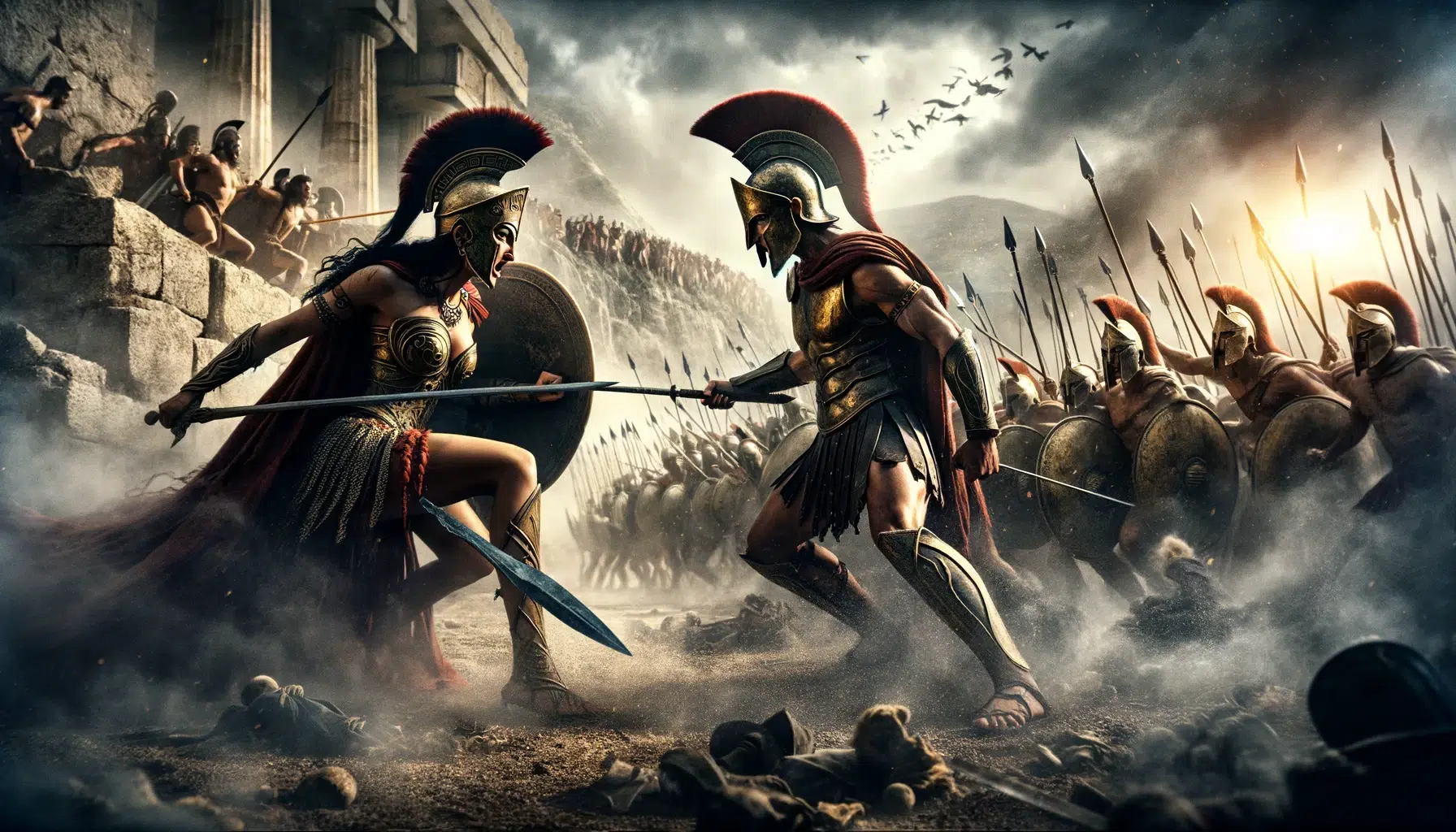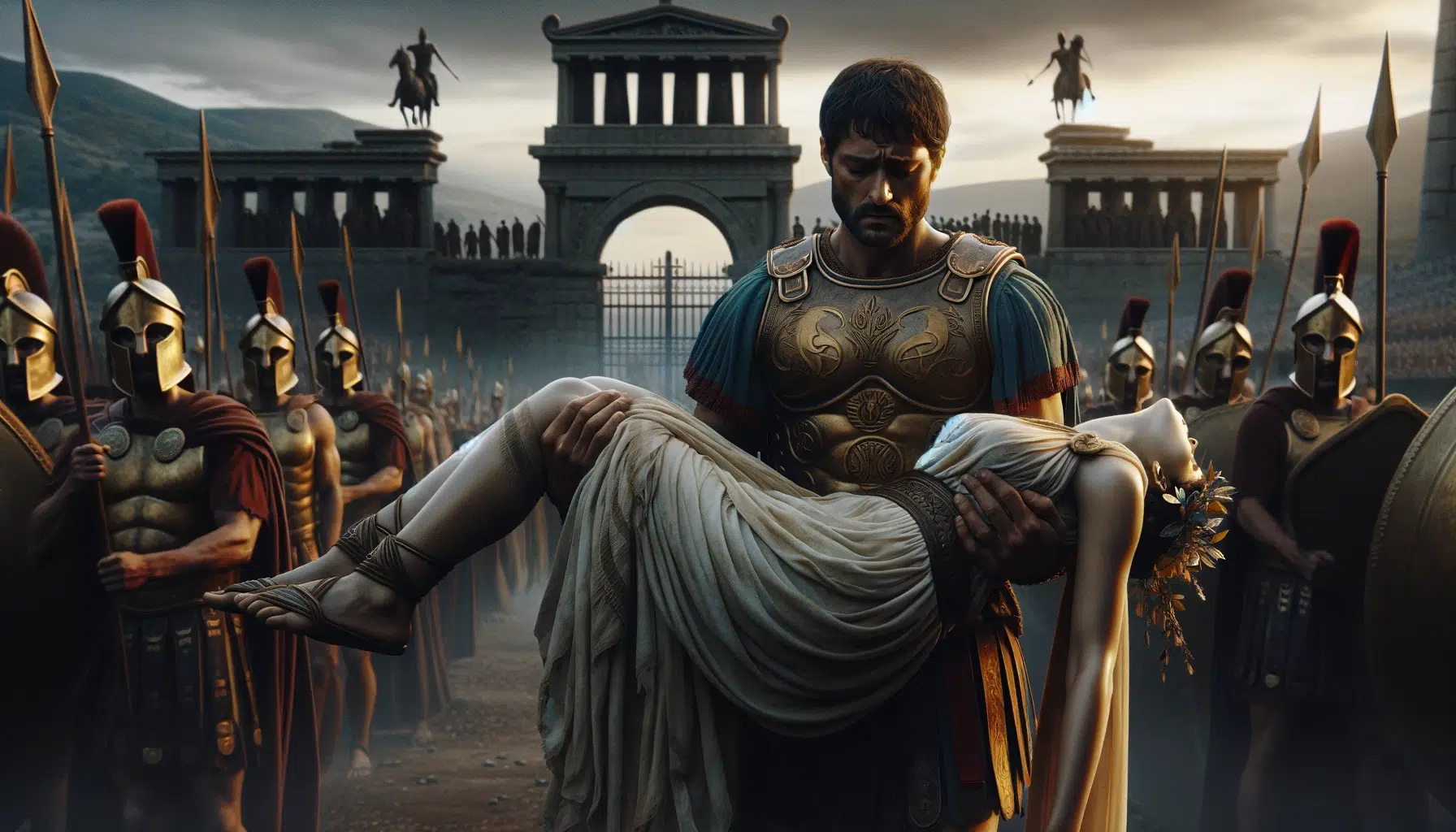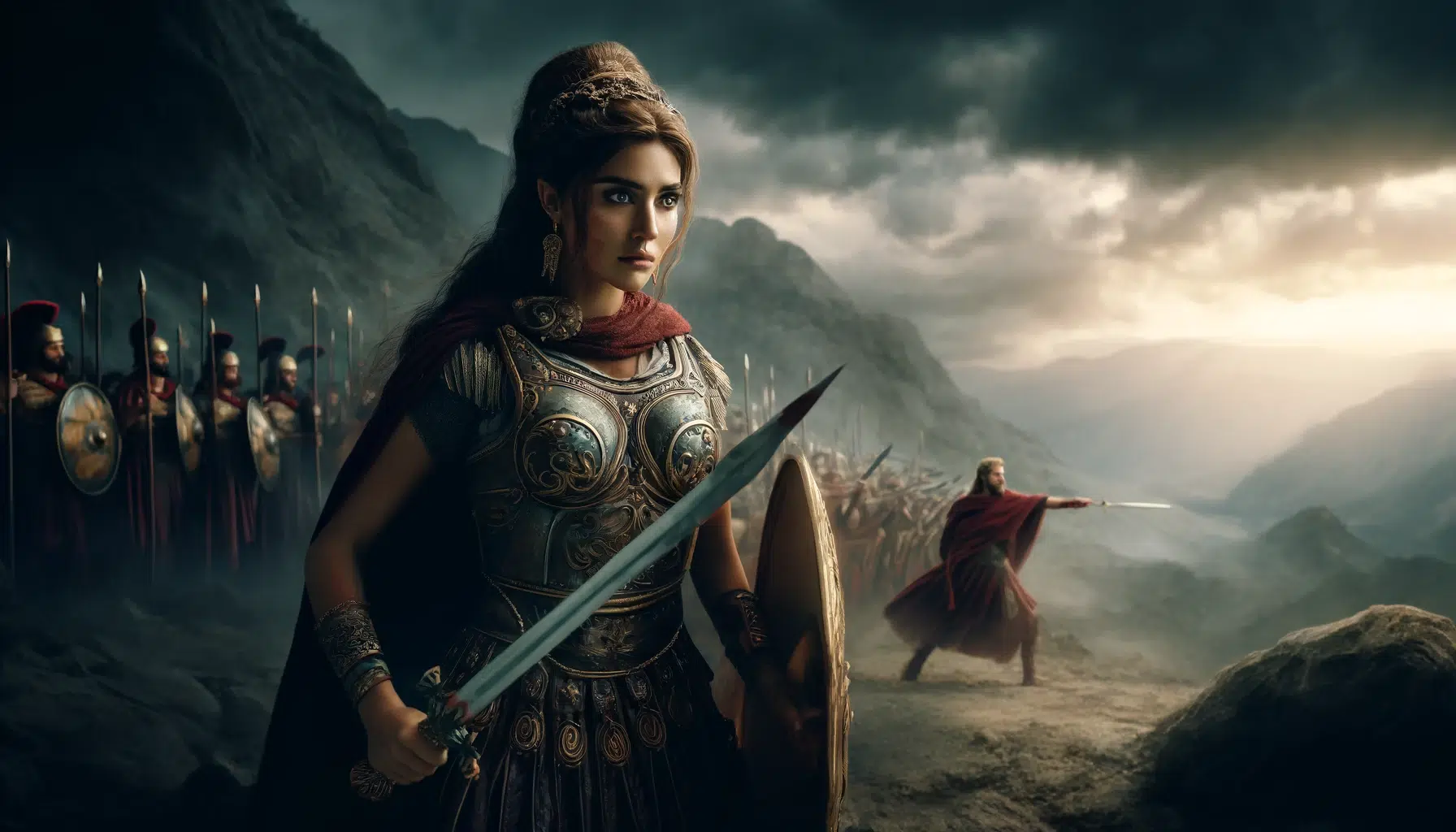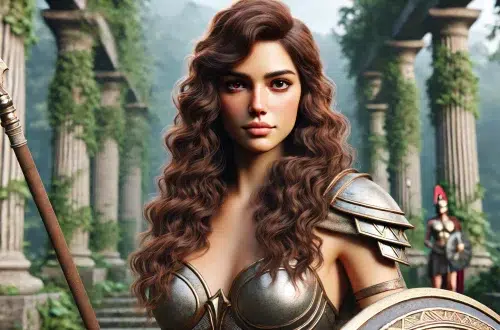
Penthesilea: Amazon Queen Who Died in Trojan War
In Greek mythology Penthesilea, the legendary Amazon Queen, she stands out as a symbol of courage and strength.
The Amazons, her kin, are fierce warrior women who forge a unique society where females lead and excel in combat.
Learn more about Greek mythology:
| Key Points | Description |
|---|---|
| Queen of the Amazons | Penthesilea assumes the role of queen after her sister, Hippolyta dies. |
| Journey to Troy | Penthesilea traveled to Troy to fight alongside the Trojans against the Greeks in the Trojan War. |
| Encounters with Achilles | Penthesilea faced Achilles, the legendary Greek warrior, in battle, resulting in her death. |
| Confrontation with Thersites | Thersites, a controversial figure, also crossed paths with Penthesilea during the Trojan War. Achilles later killed him. |
Who Were the Amazons?
The Amazons were a group of warrior women from Greek mythology.
They came from a place many believed to be near the Black Sea. This location added a touch of mystery and allure to their legends.
These women formed their own society, separate from the male-dominated worlds surrounding them.
In Amazon society, women held all the roles of power. They were warriors, hunters, and rulers.
The Amazons trained in combat from a young age, and their skills were legendary.
They lived without men, only meeting with neighbouring peoples to ensure their survival.
Mythology paints the Amazons not just as fierce fighters but also as symbols of freedom and independence.
They challenged the expectations of their time, where most societies saw women only in domestic roles.
Today, the Amazons inspire stories and characters that celebrate strong, independent women.
Their legacy continues to influence our ideas of female empowerment and equality.
Learn more about women in Greek mythology:
- Artemis: Ancient Greek Goddess of Archery
- Atalanta: Fabled Archer to Legendary Heroine
- Athena Goddess of Strategic Warfare & Wisdom
- Legacy of Archers: Women in Greek Mythology

Family of Penthesilea
Penthesilea, the legendary queen of the Amazons, had an intriguing lineage. She was the daughter of Ares, the god of war, and her mother Otrere who founded the Amazon nation.
Penthesilea had three sisters, Hippolyta, Antiope, and Melanippe, who also belonged to the lineage of fierce Amazon warriors.
Born to a god and a queen, Penthesilea quickly learned the ways of war and strategy.
Penthesilea grew up among warriors, learning to fight and lead from a young age.
Learn more about her family:
Training as an Amazon Warrior
Her path to becoming an Amazon warrior was hard but rewarding. She honed skills like archery and horse riding, which are vital to an Amazon’s life.
This tough training made her a prepared and elite soldier, standing on par with her Amazon sisters. Her impressive abilities, thanks to her divine blood, set her apart as a leader.
Within Greek myths, the Amazons hold a special place, especially for their matriarchal society. This system heavily influenced Penthesilea’s journey to becoming a queen.
With her unmatched skills and divine parentage, she naturally stepped into a leadership role.

Rising to be Queen
Some myths state that Penthesilea tragically and by accident killed her sister, Hippolyta during a hunt.
However more famous myths have Hippolyta dying at the hands of Hercules, when he wanted her magical girdle.
It had been a gift from her father, Ares, and was thought to provide strength.
After the death of Hippolyta, Penthesilea took on the mantle of queen and became the ruler of the Amazons. She became queen after proving herself in many battles. Her bravery and skill in combat were unmatched.
But Penthesilea was not only a fierce warrior; she was also a wise leader. She cared deeply for her people and worked hard to keep them safe and strong.
As the queen of the Amazons, Penthesilea held immense power and command over her people. Penthesilea’s ability to inspire her warriors was one of her greatest strengths.
She led by example, always fighting at the front lines. Her courage and determination rallied her troops and struck fear in her enemies.
These traits made her a respected and legendary figure in Amazon history.
The Amazons Were Allies to the Trojans
The Amazons played a bold role in the Trojan War. They were fierce allies to the Trojans, fighting against the Greek invaders.
The Amazons joined the war not just to help Troy but also to prove their strength and bravery to the world. Their participation had strategic importance.
The Amazons were skilled warriors, and their presence boosted the Trojans’ morale.
They also brought a new energy to the battlefield, making the Greek soldiers wary and cautious. Penthesilea had her own reasons for joining the war.
Penthesilea’s Motives for Joining the War
Penthesilea had various motivations for joining the Trojan War.
Different sources offer different explanations, adding to the intrigue and mystery surrounding her character.
- Penthesilea was a mercenary – One theory propounds that Penthesilea was a mercenary, motivated by the allure of gold. As a skilled and renowned warrior, she may have viewed the war as an opportunity to acquire wealth and treasures. However, the truth behind her mercenary status remains inconclusive.
- Penthesilea sought redemption for a grave mistake – Another possibility is that Penthesilea sought redemption and honour after a tragically she accidentally killed her sister, Hippolyta during a hunt. Joining the Trojan War could have been an attempt to cleanse her conscience and find redemption for her actions.
- Penthesilea may have been driven by a sense of honour and a desire to defend Troy – As the queen of the Amazons, she held a position of power and responsibility. Protecting the city and its inhabitants could have been a matter of honor and duty for her.
The Battle of Troy: Penthesilea vs. Achilles

The most famous battle of Penthesilea was with Achilles, a Greek hero.
Their fight is remembered well in the Trojan War. Penthesilea led her army into battle against the Greeks in the epic clash at Troy.
In the midst of the bloody conflict, she faced off against legendary Greek heroes, including Achilles and Ajax.
The battle between Penthesilea and Achilles was one of the most dramatic moments in the Trojan War. It happened when Achilles, the greatest Greek warrior, met Penthesilea in combat. Both were unmatched in battle, making their fight fierce and intense.
Achilles defeated Penthesilea, but the moment he saw her face as she fell, he felt a mix of respect and sadness.
Legends say that Achilles fell in love with Penthesilea as she died, struck by her beauty and bravery. This emotional twist added a layer of tragedy to the battle, showing that even enemies can recognize and respect each other’s valor.
The Battle of Troy was a pivotal moment in the Trojan War, as well as in the legendary tales of Penthesilea. It showcased her prowess as a warrior queen and the strength of her Amazon army.
Different cultures have interpreted their encounter in various ways. In some stories, Achilles’ feelings of love and regret highlight the human side of war, where respect for an opponent can emerge even in violence.
Other interpretations focus on Penthesilea’s courage, using her story to illustrate themes of honour and redemption.
Learn more about the Trojan War in Greek mythology:
- Achilles: Greek Warrior Hero’s Journey from Glory to Grief
- Apollo: Exploring the Archer God’s Myths and Legends
- Hector of Troy: Legendary Trojan Warrior
- Paris: Tragic Hero, Villain or Pawn of the Gods
- Philoctetes: The Legendary Greek Archer and Healer
Death of Penthesilea

Penthesilea’s death is a central event in her myth.
In one version, Achilles, the legendary Greek hero known for his great skill in battle, struck her down with a powerful spear. This version emphasizes Penthesilea’s vulnerability and Achilles’ superior strength and skill.
In another version, Penthesilea managed to slay Achilles in combat but was then killed by him in turn. This alternative storyline highlights Penthesilea’s prowess as a formidable warrior and the tragic nature of her fate.
Following Penthesilea’s death, the Greek warrior Thersites mocked Achilles for showing mercy towards the fallen Amazon queen. Thersites’ taunts were met with retaliation, as Achilles killed him in response to the mockery.
Burial of Penthesilea and Reactions
After Penthesilea’s death, great things happened.
Achilles, being unbeatable, felt respect for her. After the fierce battle between Penthesilea and Achilles, the Greek warrior was captivated by the beauty of the fallen Amazon queen.
In an act of mercy, Achilles agreed to return Penthesilea’s body to the Trojans for a proper burial. He was said to have grieved, seeing her as an equal. Thus honouring her as a worthy adversary and showing respect to her people.
The myths surrounding the burial of Penthesilea present varying accounts.
Some versions suggest that Diomedes, another Greek hero, callously threw her body into the River Scamander, denying her a dignified resting place.

Other sources claim that Achilles himself took responsibility for the burial and laid Penthesilea to rest on the banks of the Xanthus River.
This to pay homage to her valour and ensuring her eternal peace. The burial of Penthesilea carried significant symbolic weight for both the Greeks and the Trojans.
For the Greeks, it represented an act of honour, acknowledging the bravery and prowess of their fallen adversary. The willingness of Achilles to respect Penthesilea even in death.
It showcased his understanding of the warrior spirit and the importance of according recognition to worthy opponents.
For the Trojans, the burial served as a poignant reminder of the tragic toll of war and the shared humanity that transcends the boundaries of battle.
Penthesilea, an outsider and enemy, was granted the right to a proper burial, emphasizing the universal value of respecting the deceased.
Symbols and Iconography of Penthesilea

Penthesilea is a key figure in ancient art. Artists have long depicted her as a warrior queen. This celebrates her leadership and skilled combat, making her Amazon vision powerful.
Artistic Representations
Ancient Greek art and sculptures feature Penthesilea boldly.
They showcase her with great Amazonian symbolisms, especially in battle.
These images convey her relentless strength and fighting spirit.
- Vase Paintings: Ancient vases include Penthesilea with other heroes, highlighting her mythological importance.
- Sculptures: Sculptures often show her fighting, focusing on her powerful physique and warrior nature.
- Mosaics: These mosaics enrich her tales with detailed cultural and artistic references.
Weapons and Armour
Penthesilea’s weapons and armour show her as a fierce fighter and leader. This tells us a lot about her role in battle.
- Spear and Shield: Shown with a spear and shield, these signify her battle prowess and preparedness.
- Helmet and Breastplate: Her detailed helmet and breastplate emphasize her strength and warrior look.
- Adornment with Symbols: Symbols on her gear, like the Gorgon head, dive into deeper mythological meanings.
Penthesilea in Literature and Art

Penthesilea’s myth greatly influenced literature and art, showing her long-lasting impact.
Her story has been reimagined from ancient times to modern days.
This shows how different artists and writers have seen her throughout history.
Classical Literature
In old Greek texts like Homer’s “Iliad,” we first read about Penthesilea.
She was also a key part of the “Posthomerica” by Quintus of Smyrna.
These writings have kept her story alive, making her a legendary character in Greek mythology.
Modern Adaptations
Today, many authors, playwrights, and artists still take on Penthesilea’s myth.
Works like Heinrich von Kleist’s play “Penthesilea” and newer novels often draw on her story.
They find new ways to show her character and make her story relevant to current times and themes.
The Temple of Apollo Epicurius, located in Bassae, Greece, is a UNESCO World Heritage.
Site renowned for its architectural beauty and remarkable reliefs.
Within the temple, visitors can admire artworks that depict Penthesilea in all her fierce glory.
This captures the essence of her character and the epic battles she engaged in.
Similarly, the Temple of Zeus at Olympia, another UNESCO World Heritage Site, features stunning sculptures and friezes that celebrate ancient Greek mythology.
Among these artworks, Penthesilea’s story is brought to life.
The Legend of Penthesilea in Historical Context

The legend of Penthesilea blends myths with real history.
It gives us a peek into ancient stories about warrior women.
These tales might have shaped the legend of Penthesilea.
Comparisons with Historical Figures
When we look at Penthesilea’s story, we find similarities with real figures.
For example, Tomyris, a Massagetae queen, is known for battling Cyrus the Great.
There were also the Scythian women who fought in battles just like men.
These similarities connect myth to reality, showing why Penthesilea’s tale is so compelling.
Possible Real-Life Inspirations
It’s possible that real warrior women inspired the Amazon queen’s tales.
For instance, archaeologists have found graves of female fighters in the Eurasian steppes.
This evidence suggests that ancient women did fight.
These facts mix with myths to create Penthesilea’s legend.
The mash-up of fact and fiction highlights humanity’s long-standing interest in powerful women.
| Historical Figures | Legendary Parallels |
|---|---|
| Tomyris | Queen of the Massagetae, known for her battle with Cyrus the Great |
| Scythian Women | Historical accounts of female Scythian warriors riding into battle |
| Archaeological Finds | Graves of female warriors discovered in Eurasian steppes |
Conclusion
As we end our look into Amazon Queen Penthesilea’s life, her story continues to ring true over the ages.
Grounded in Greek myths, she stands for courage, leading, and empowering women.
Her tale, notably her bravery in the Trojan War and facing Achilles, has influenced both ancient and modern culture.
Penthesilea’s image is well preserved in various artforms and texts.
From the ancient Iliad to today’s books and artworks, her legacy lives on.
Her battle gear has been finely detailed, showing her strong image and sparking interest in her story.
Over time, Penthesilea has remained an inspiration for women’s strength and leadership.
As a legendary character, she not only brings out the Amazon’s historical tale but also reflects women’s resilience and bravery.
This story still captures hearts, showing how Greek mythology, and she, continue to be remembered.




